Equipment
Talking counterbalancing with Steve Boccieri and Tom Stickney
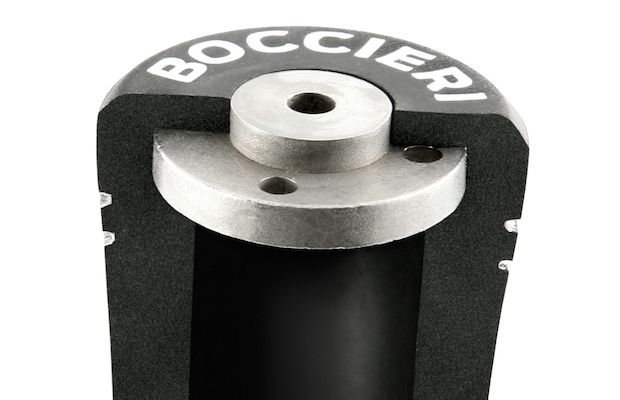
Could counterbalancing be the next technology major OEMs market? Steve Boccieri of Boccieri Golf thinks so. “The next frontier is counterbalancing,” he boldly declared.
Boccieri, the inventor of the Heavy Putter a decade ago, admittedly has a vested interest in the resurgence of counterbalancing taking over the market. His company recently released the Secret Grip: a (nearly) standard grip with a weight in the butt end. The Secret Grip, at 92 grams, is about 40 grams heavier than a traditional grip, such as the Golf Pride Tour Velvet, which is 50 grams. Thus far, the grip has been well-received both on Tour and by the general public.
Although the numbers have likely increased, Boccieri Golf’s website states:
“Over 3,000 golfers have tested the Secret Grip, with 97 percent preferring it to a conventional grip.
Golf Labs conducted an independent test of the Secret Grip and found 87 percent of golfers, using a 6-iron, increased their ball speed, the leading factor in distance.”
Boccieri indicated that counterbalancing has been popular for years, stating that Ben Hogan and Jack Nicklaus both counterweighted their clubs.
Boccieri reports that Secret Grips can be found in every major OEMs’ tour van right now and that players are requesting the grips. Already on Tour, the following players (among many others) are using the Secret Grip or counterbalancing their clubs: Sergio Garcia, J.B. Holmes, Retief Goosen, Bo Van Pelt, Rory Sabbatini, Ernie Els, and Ryan Moore.
The next step for Boccieri: offering the Secret Grip in more styles, such as the ribbed reminder version Thomas Bjorn has requested. Presently, the company is working with Lamkin to give golfers more Secret Grip options.
At the retail level, the Secret Grip has been well received. And at the Boccieri facility, the company offered golfers who purchased at least six Secret Grips the following deal: try the grips for 30 days. If you aren’t satisfied, we’ll regrip your clubs with the grips of your choosing for free. More than 90 percent of golfers stuck with the Secret Grips. Thus, according to Bocccieri, “the consumer is accepting the product.” Here’s a look at the Secret Grip specs and options.
Secret Grip Original: $12.99
- Injection molded tungsten cap
- Heavier rubber compound
- 92-gram total weight
- 1-inch longer than standard grip
- Built-up lower hand
- Sizes: Standard or Midsize
- Styles: Multi-direction pattern and cord
- Colors: Black, Red, White or Blue
Secret Grip Putter: $19.99
- Injection molded tungsten cap
- Heavier rubber compound
- Sizes: Classic, Midsize or Jumbo
- Colors: Black or Black/Green
- Weights: 100 grams, 155 grams or 165 grams
- Note: Black is only available in Midsize
So, what are the benefits of counterbalancing a club?
According to Boccieri, “When you raise the balance point you make the club more efficient.” Beyond that, Boccieri claims that counterbalancing a club (and using the Secret Grip in particular):
- Creates a better plane on the takeaway
- Allows the hands to set more quickly
- Allows for a smoother transition
- Helps a golfer “hold the angle” longer
- Contributes to a fuller extension
Using the Secret Putter Grip:
- Contributes to overall stroke stability
- Quiets the hands during the stroke
- Facilitates a pendulum stroke
Offering his own take, Golf Magazine Top 100 Teacher Tom Stickney II indicated that counterbalancing a club makes the head feel lighter.
Stickney, who counterweights his wedges and putter, believes that the demise of backweighting over the past couple of decades is mostly a function of the fact that OEMs didn’t want to add to the cost of the golf club and decided instead to market other technologies.
In search for comparative advantages, he sees the return of counterbalancing as a real possibility. He believes further that the recent popularity of counterbalanced putters could lead to a spillover of the technology into other club types.
Stickney’s only cautions: Adding weight to the end of the club increases static weight and decreases swingweight. Further counterbalancing a club may make it was to release more quickly, particularly in the woods, which promotes a draw.
- LIKE8
- LEGIT0
- WOW0
- LOL0
- IDHT0
- FLOP0
- OB0
- SHANK0
Whats in the Bag
WITB Time Machine: Danny Willett’s winning WITB, 2016 Masters
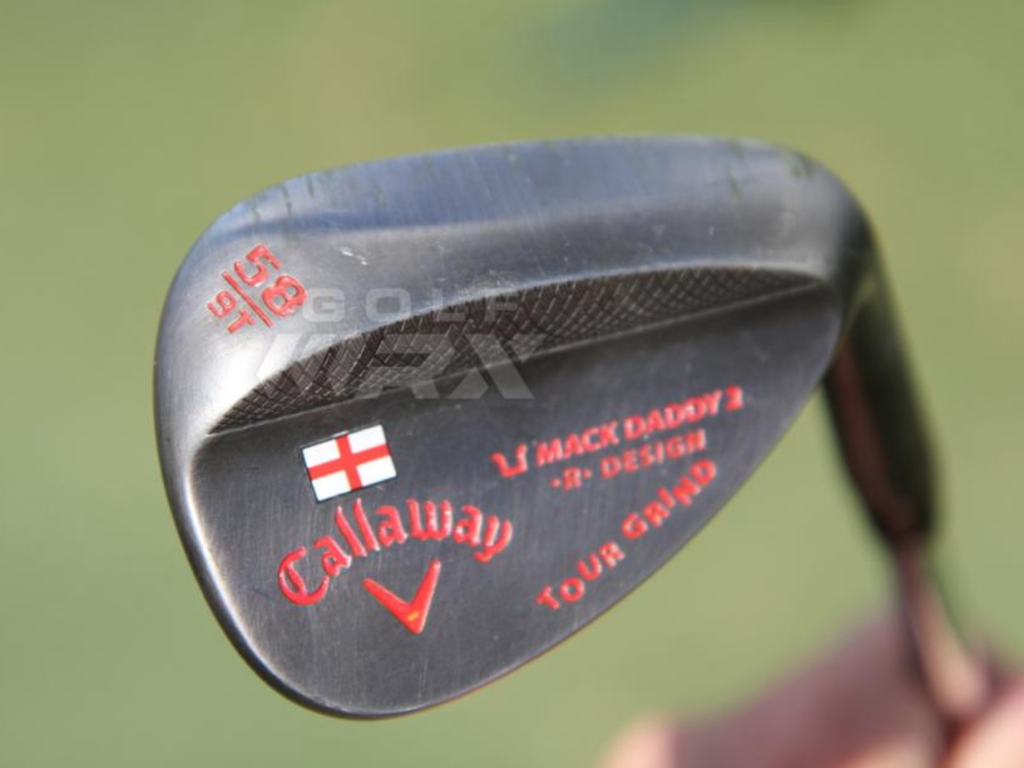
Driver: Callaway XR 16 (9 degrees)
Shaft: Mitsubishi Rayon Diamana W-Series 60 X
Length: 45.5 inches
3-wood: Callaway XR 16 (15 degrees)
Shaft: Mitsubishi Rayon Diamana W-Series 70X
5-wood: Callaway XR 16 (19 degrees)
Shaft: Mitsubishi Rayon Diamana W-Series 80X
Irons: Callaway Apex UT (2, 4), Callaway Apex Pro (5-9)
Shaft: True Temper Dynamic Gold X100 Superlite
Wedges: Callaway Mack Daddy 2 (47-11 S-Grind) Callaway Mack Daddy 2 Tour Grind (54-11, 58-9)
Shaft: True Temper Dynamic Gold X100 Superlite
Putter: Odyssey Versa #1 Wide (WBW)
Lie angle: 71 degrees
Ball: Callaway Speed Regime SR-3
Check out more photos of Willett’s equipment from 2016 here.
- LIKE2
- LEGIT0
- WOW1
- LOL0
- IDHT0
- FLOP0
- OB0
- SHANK0
Equipment
Project X Denali Blue, Black shaft Review – Club Junkie Review
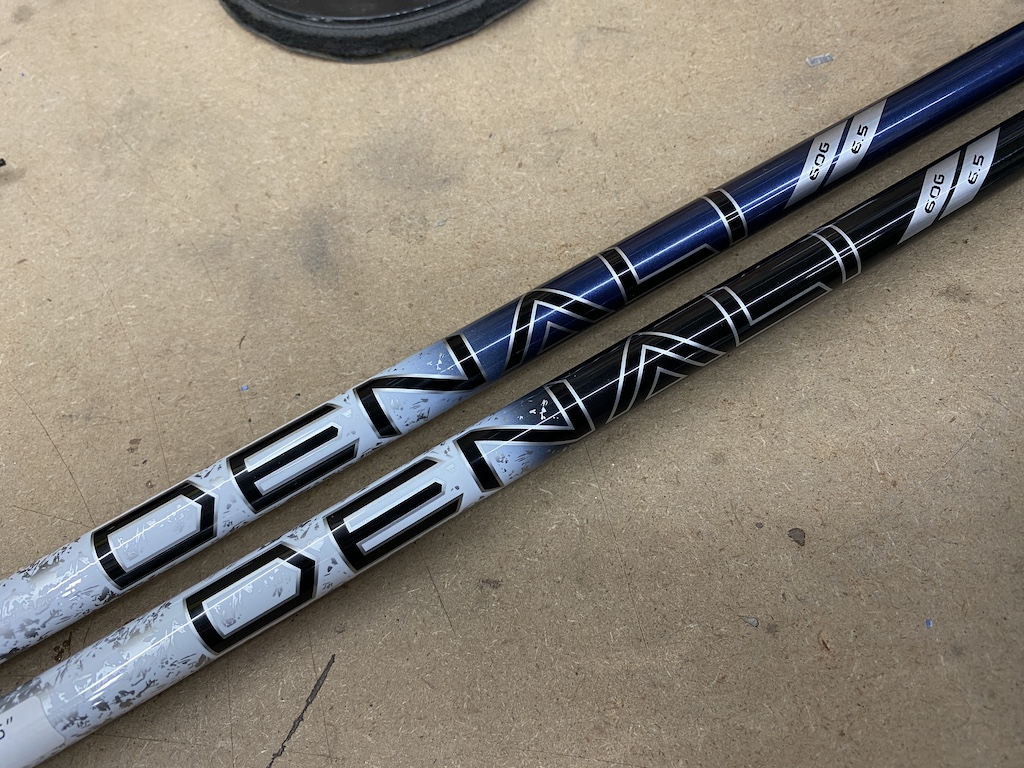
Originally, Project X was known for low-spin steel iron shafts. However, the company might now be known for wood shafts. Denali is the newest line of graphite shafts from Project X. With the Denali line, the company focuses on feel as well as performance.
There are two profiles in the Denali line, Blue and Black, to fit different launch windows. Denali Blue is the mid-launch and mid-spin profile for players who are looking for a little added launch and Denali Black is designed for low-launch and low-spin. Both models are going to offer you a smooth feel and accuracy.
For a full in-depth review check out the Club Junkie podcast on all podcast streaming platforms and on YouTube.
Project X Denali Blue
I typically fit better into mid-launch shafts, as I don’t hit a very high ball so the Denali Blue was the model I was more excited to try. Out of the box, the shaft looks great and from a distance, it is almost hard to tell the dark blue from the Denali Black. With a logo down install of the shaft, you don’t have anything to distract your eyes, just a clean look with the transition from the white and silver handle section to the dark navy mid and tip.
Out on the course, the Blue offers a very smooth feel that gives you a good kick at impact. The shaft loads easily and you can feel the slightly softer handle section compared to the HZRDUS lineup. This gives the shaft a really good feel of it loading on the transition to the downswing, and as your hands get to impact, the Denali Blue keeps going for a nice, strong kick.
Denali Blue is easy to square up at impact and even turn over to hit it straight or just little draws and most of the flex of the shaft feels like it happens right around where the paint changes from silver to blue. The Blue launches easily and produces what I consider a true mid-flight with the driver. While it is listed as mid-spin, I never noticed any type of rise in my drives. Drives that I didn’t hit perfectly were met with good stability and a ball that stayed online well.
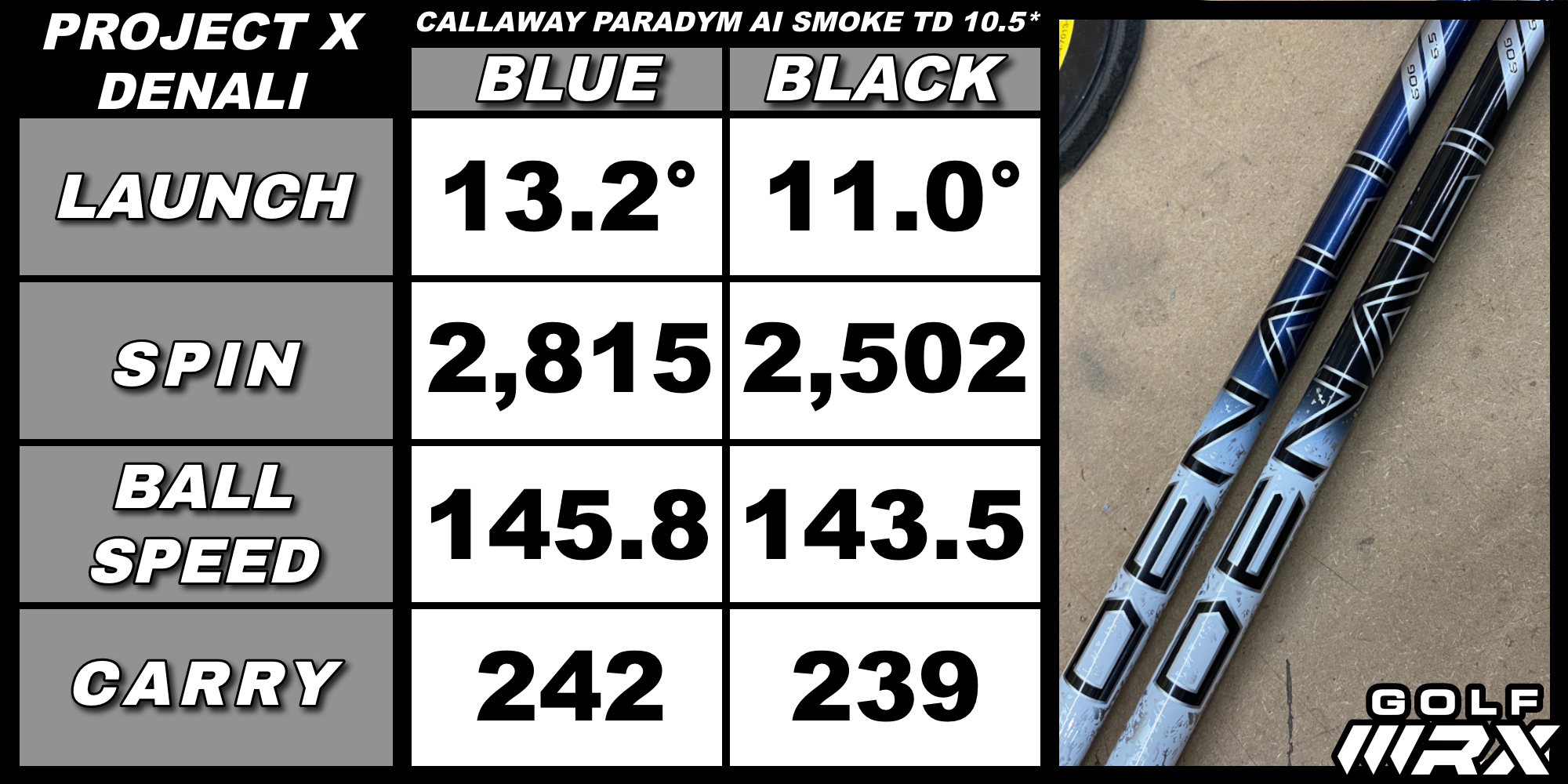
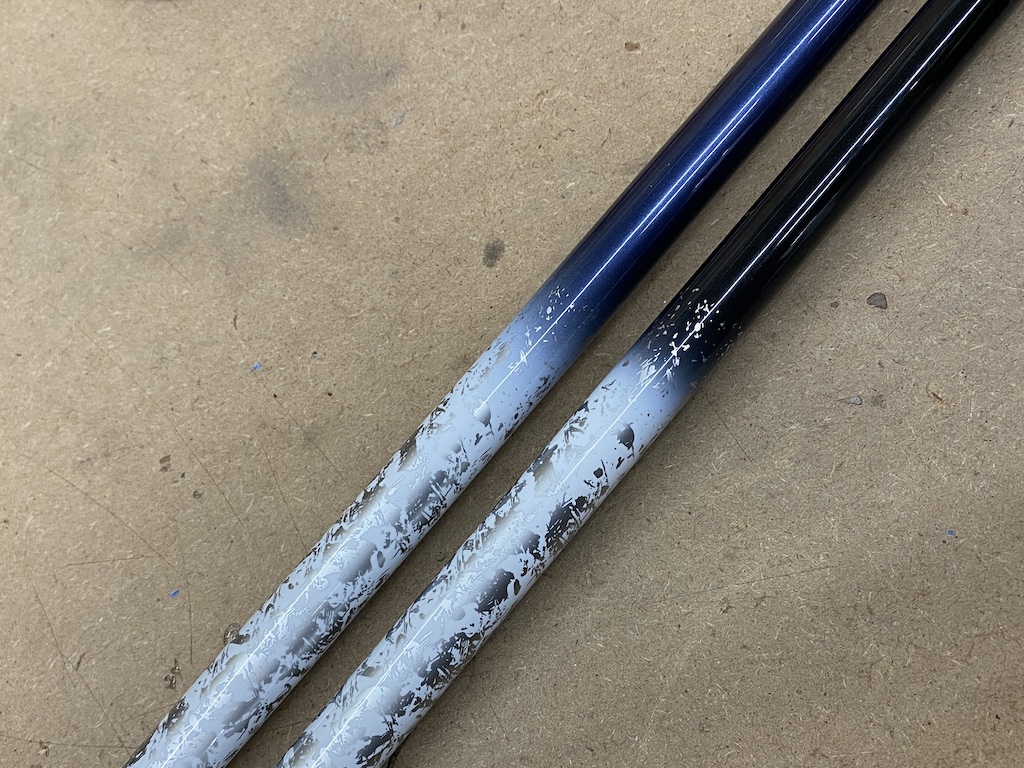
Project X Denali Black
When you hold the Denali Black in your hands you can tell it is a more stout shaft compared to its Blue sibling by just trying to bend it. While the handle feels close to the Blue in terms of stiffness, you can tell the tip is much stiffer when you swing it.
Denali Black definitely takes a little more power to load it but the shaft is still smooth and doesn’t give you any harsh vibrations. Where the Blue kicks hard at impact, the Black holds on a little and feels like keeps you in control even on swings that you try and put a little extra effort into. The stiff tip section also makes it a little harder to square up at impact and for some players could take away a little of the draw from their shot.
Launch is lower and more penetrating compared to the Blue and produces a boring, flat trajectory. Shots into the wind don’t rise or spin up, proving that the spin stays down. Like its mid-launch sibling, the Black is very stable and mishits and keeps the ball on a straighter line. Shots low off the face don’t get very high up in the air, but the low spin properties get the ball out there farther than you would expect. For being such a stout shaft, the feel is very good, and the Denali Black does keep harsh vibrations from your hands.
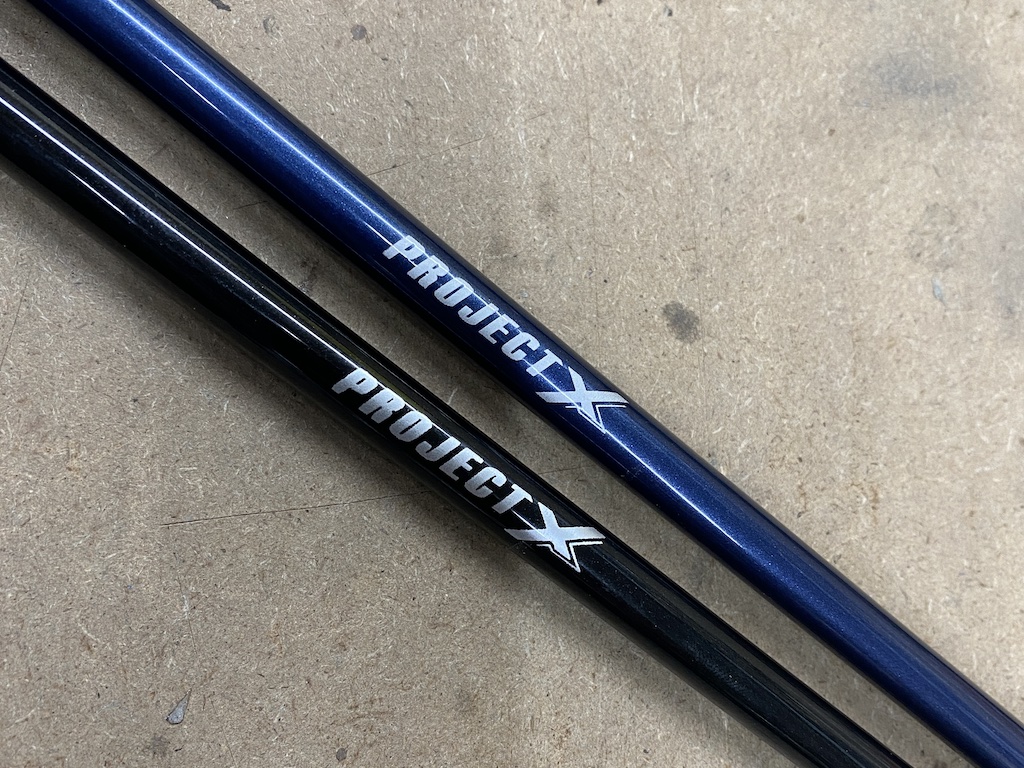
Overall the Project X Denali Blue and Black are great additions to the line of popular wood shafts. If you are looking for good feel and solid performance the Denali line is worth trying out with your swing. Choose Blue for mid-launch and mid-spin or Black for lower launch and low spin.
- LIKE1
- LEGIT1
- WOW1
- LOL0
- IDHT0
- FLOP0
- OB0
- SHANK0
Equipment
What we know about Bryson DeChambeau’s 3D-printed Avoda irons
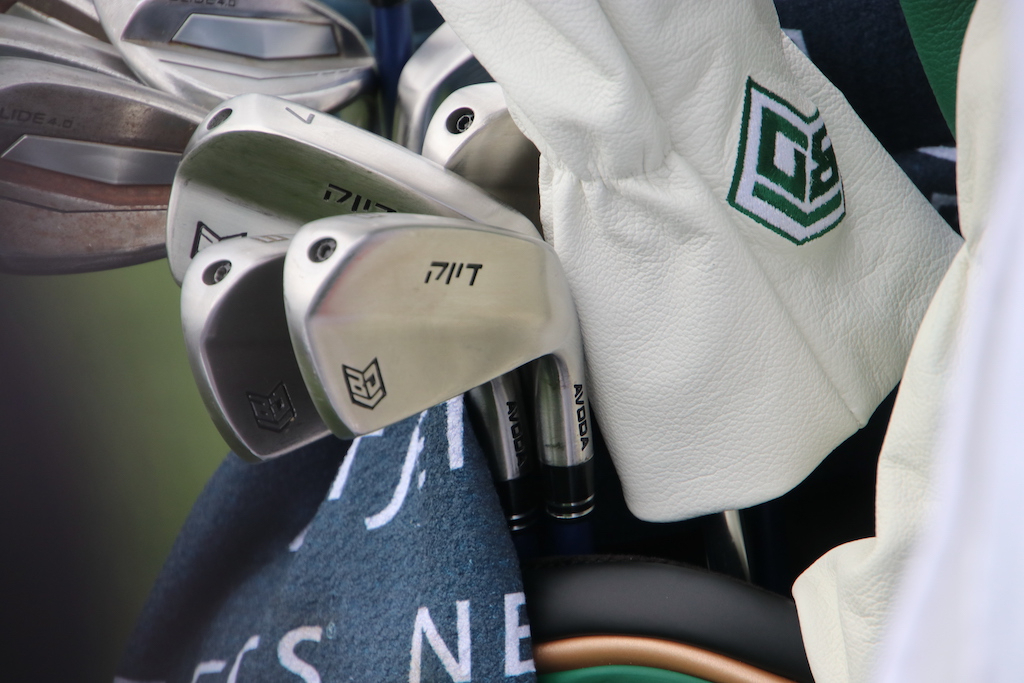
Bryson DeChambeau fired an opening-round 7-under 65 at Augusta National, hitting an impressive 15 of 18 greens in regulation in the process. Golf’s mad scientist’s play grabbed headlines and so too did his equipment. In place of the Ping i230 irons he had in the bag last week for LIV Golf’s Miami event, DeChambeau is gaming a prototype 5-PW set of irons from little-known direct-to-consumer manufacturer Avoda.
What is Avoda Golf?
Founded by Tom Bailey, also a Mike Schy student like Bryson DeChambeau, Avoda Golf is a direct-to-consumer golf equipment company that currently manufactures both single and variable-length irons in one model that are available for pre-order.
What irons is Bryson DeChambeau playing?
Per multiple reports, DeChambeau is playing a custom-designed set of single-length irons that incorporate bulge and roll into the face design. The two-piece 3D-printed irons were reportedly only approved for play by the USGA this week, according to Golfweek’s Adam Schupak.
Regarding the irons, DeChambeau told Golf Channel the irons’ performance on mishits was the determining factor in putting them in play this week. “When I mishit on the toe or the heel,” DeChambeau said. “It seems to fly a lot straighter for me and that’s what has allowed me to be more comfortable over the ball.”
What can we tell about the design of the clubs?
These days, it is a little hard to speculate on what is under the hood with so many hollow body irons. DeChambeau’s irons look to be hollow on the lower section as they do flare back a decent amount. That “muscle” on the back also looks to be fairly low on the iron head, but we can assume that is progressive through the set, moving up higher in the short irons.
A screw out on the toe is probably used to seal up the hollow cavity and used as a weight to dial in the swing weight of the club. From pictures, it is hard to tell but the sole looks to have a little curve from heel to toe while also having some sharper angles on them. A more boxy and sharper toe section looks to be the design that suits Bryson’s eye based on the irons he has gravitated toward recently.
What are bulge and roll, again?
Two types of curvature in a club face, traditionally incorporated only in wood design. Bulge is heel-toe curvature. Roll is crown-sole curvature. Both design elements are designed to mitigate gear effect on off-center strikes and produce shots that finish closer to the intended target line. (GolfTec has an excellent overview of bulge and roll with some handy GIFs for the visual learner)
What else is in DeChambeau’s bag?
Accompanying his traditional Sik putter, Bryson builds his set with a Ping Glide 4.0 wedges, a Krank Formula Fire driver and 5-wood, and a TaylorMade BRNR Mini Driver, all with LA Golf graphite shafts.
- LIKE73
- LEGIT22
- WOW17
- LOL7
- IDHT4
- FLOP2
- OB5
- SHANK14
-

 19th Hole3 days ago
19th Hole3 days agoDave Portnoy places monstrous outright bet for the 2024 Masters
-

 19th Hole3 weeks ago
19th Hole3 weeks agoJohn Daly stuns fans into silence with brutal opening tee shot on PGA Tour Champions
-

 19th Hole2 weeks ago
19th Hole2 weeks agoThings got heated at the Houston Open between Tony Finau and Alejandro Tosti. Here’s why
-

 19th Hole4 days ago
19th Hole4 days agoTiger Woods arrives at 2024 Masters equipped with a putter that may surprise you
-

 19th Hole1 week ago
19th Hole1 week agoReport: Tiger Woods has ‘eliminated sex’ in preparation for the 2024 Masters
-

 19th Hole3 weeks ago
19th Hole3 weeks agoCharlie Woods finds it tough going on American Junior Golf Association debut
-

 19th Hole2 weeks ago
19th Hole2 weeks agoAddiction, spinal fusion, and scam artists – Everything Anthony Kim revealed in candid interview with David Feherty
-

 19th Hole1 week ago
19th Hole1 week agoAnthony Kim says doctors told him that he ‘may not have much time left’ ahead of LIV return

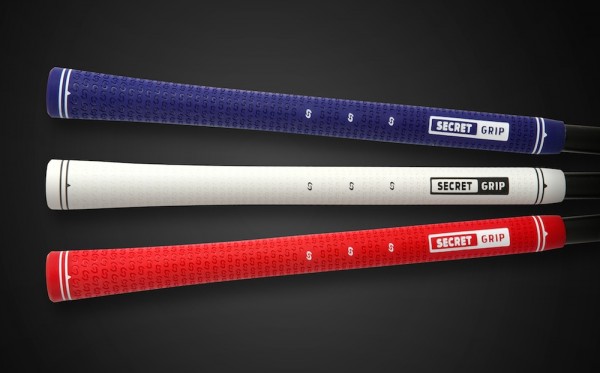

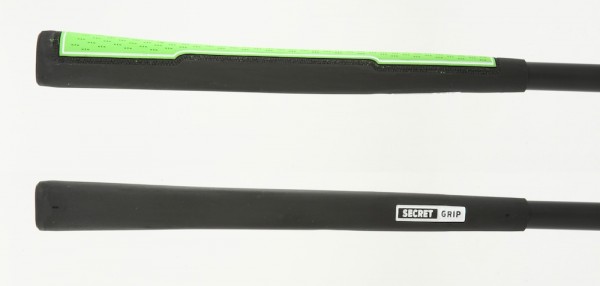


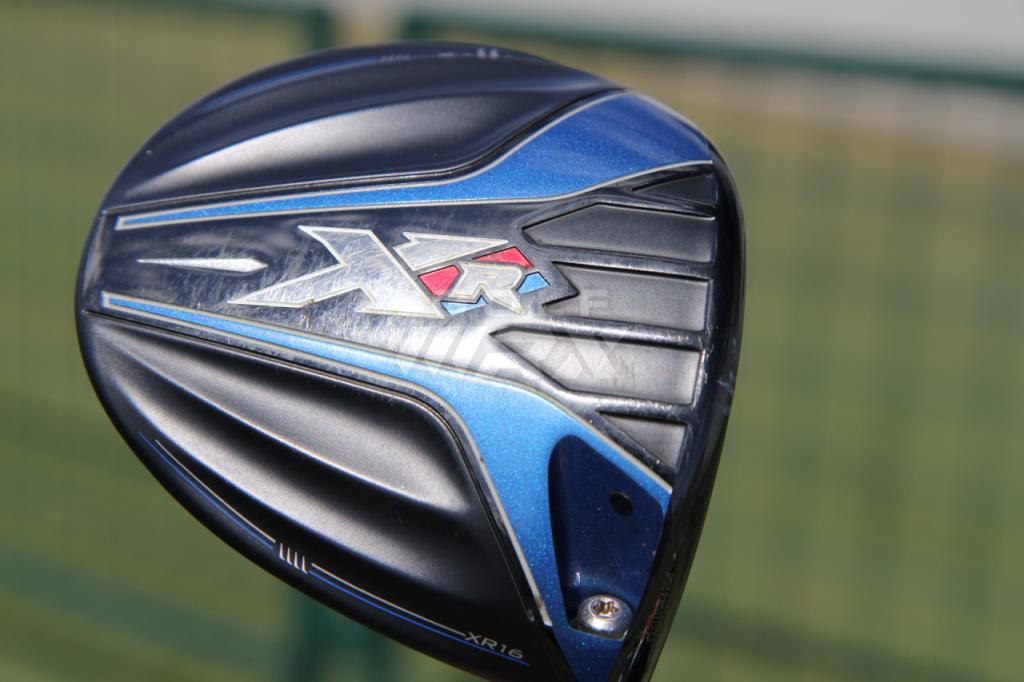
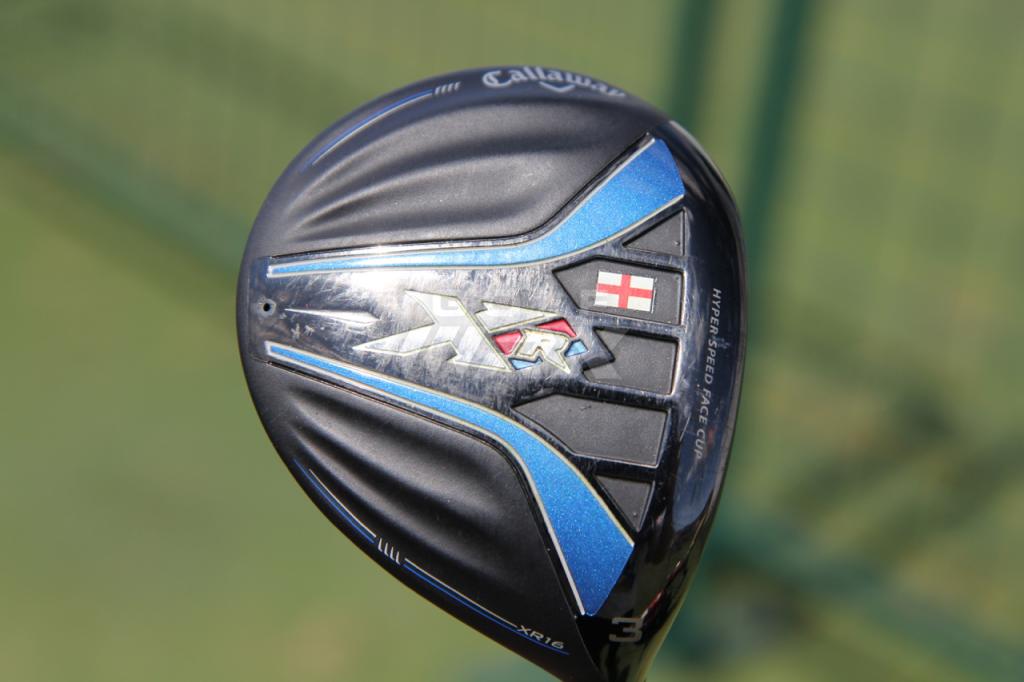

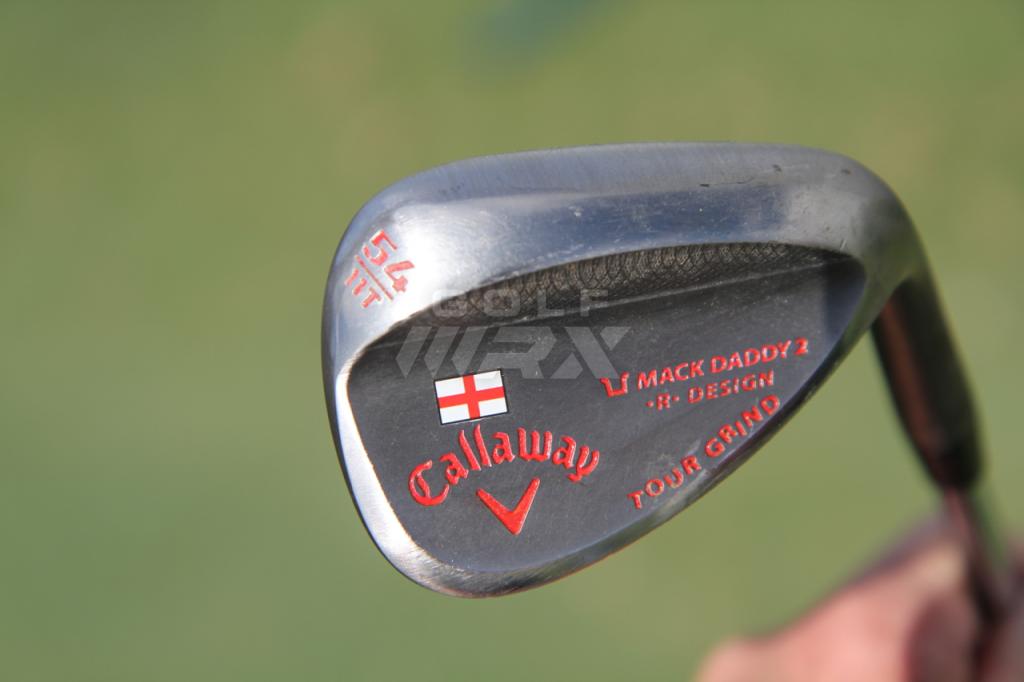
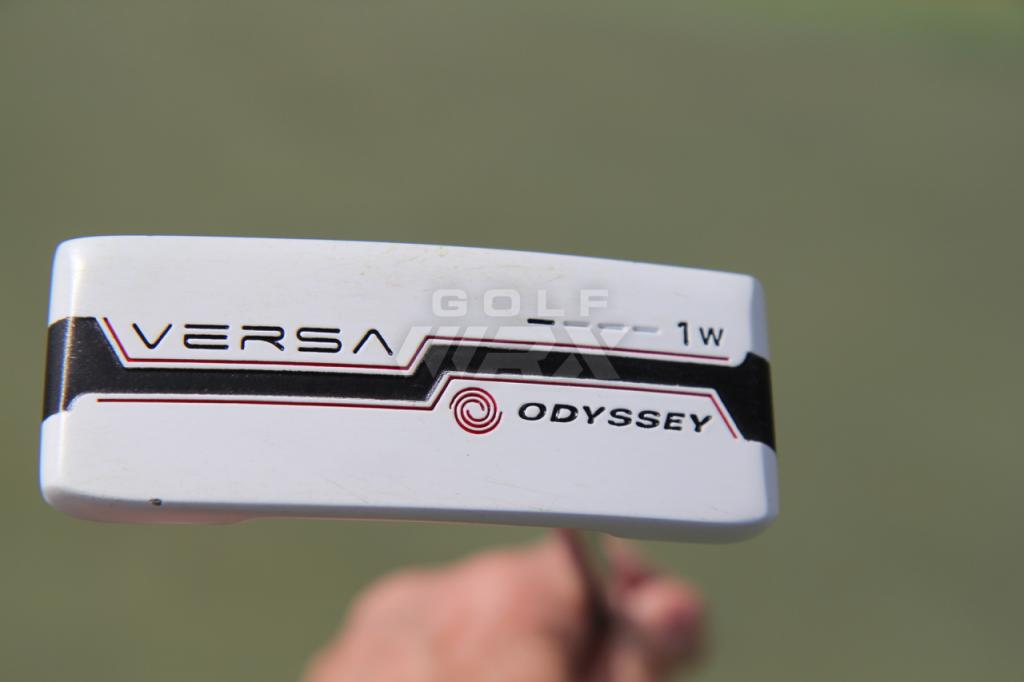














steve parrott
Sep 12, 2014 at 1:03 pm
A much easier and cheaper way to counterbalance is to add a carriage bolt(about 10-15 cents each a any hardware store)to the grip end of the shaft. Then re-grip with your favorite grip. The bolts come in different lengths (longer is heavier) and the head of the bolt is nearly the same size as the outside diameter of the shaft. The rounded end of the bolt does not cause any issues with the re-grip. The new grip installed will hold the bolt in place so no wiggles or rattles. I’ve even experimented with adding lead tape wrapped around the bolt to increase the weight. Very simple, very cheap and very easy to install.
Jonzy
Sep 8, 2014 at 1:22 pm
I got a couple of these 2 years ago when they offered them free thru GG, Dick’s and Edwin Watts and put them on my wedges. I loved them and I feel that I got more accurate with them, but I’m not paying that price per grip. I’ve ended up buying the Tour Lock Pro weight that weighed about the same as the Boccieri one to see if I would get the same result and so far I’m happy with it. Plus, when I regrip, I can re-use the weight.
Mark
Sep 6, 2014 at 10:50 am
I just installed The Secret putting grips on a two old Ping Anser and B-60 putters as an experiment. and LOVE them. I’ve become pretty “yippie” as I’ve aged (57) and the counter-balancing has taken my hands significantly out of my stroke. I used a long putter for years, but have regained confidence with the added weights.
If you suffer from the yips, I’d absolutely give it a try…..not sure on the irons though
Eric
Sep 6, 2014 at 10:33 am
So, does counterbalancing promote a draw or a fade??? I am hearing differing opinions on this. Tom, you state at the end of your article that it promotes a draw, but some of the responses are saying the exact opposite……what is the correct answer?
Tom Stickney
Sep 6, 2014 at 3:27 pm
It promotes a draw for most people that I’ve seen professionally.
Try one
Sep 7, 2014 at 2:27 am
Which is not a good way to show that a person like Nicklaus, a perennial cutter of the ball is promoting it. Confusing, to say the very least. The science needs to be explained further.
S
Sep 6, 2014 at 8:32 am
Balance Certified is another company who makes counter balance weights for all clubs. They are a bit more expensive but you only have to buy them once which makes the cost negligible.
Try one
Sep 6, 2014 at 2:58 am
It’s not for everyone, just like anything else.
If you’re a hooker of the ball and want to correct it, the counterbalance will work for you nicely.
But with too much counterbalance, for a lot of people, it also robs them of the traditional swingweighted feeling of the clubhead at the end of the stick, so most people will struggle to fire the club through enough and lose all kinds of speed and control.
It’s not for everyone. Try one grip on a mid iron that you normally don’t hit very often and see what happens before you do the whole set.
Eric
Sep 6, 2014 at 10:27 am
I am a bit confused about your statement regarding someone being a hooker of the ball, that counterbalancing will help with that……Stickney specifically states that counterbalancing promotes a draw……..who is correct? Your statement is a direct contradiction of his….
Tom Stickney
Sep 6, 2014 at 3:28 pm
It depends where the wt is located. Deeper in the grip promotes a fade. Higher a draw
Try one
Sep 7, 2014 at 2:25 am
Eric,
I was specifically talking about the Boccieri grip, NOT the other counter-balance weight kits that allow you to move weight down into the shaft more. The Boccieri grip has a fixed 17 gram weight at the very end of the grip (therefore the shaft), in addition to the heavy rubber grip weight total.
The other aspect of the counter-balance that is not mentioned is the fact that it also makes the shaft play much much stiffer. That probably won’t help people that need a softer, more whippier transition as the counterweight will take that away.
Jason
Sep 5, 2014 at 9:44 pm
Why shouldn’t I just by the tour lock stuff counterweight system? When these grips are ready to be changed, do I throw the grip and weight away? If I bought the tour lock system , I could make the weight investment once, and choose any grip I want.
Jeffcb
Sep 5, 2014 at 9:06 pm
I tried them and what I noticed is that they slow my hands down. I like to hit a draw but with the weights it was harder for me personally to release correctly. Nicklaus hit a fade, Hogan struggled with a hook, both good reasons why back weighting might be beneficial to slow one’s hands. Just wasn’t for me.
Kevin
Sep 5, 2014 at 5:49 pm
Tom,
How does the counter weights effect your wedges in trajectory and distance ? Also if one was installed on a driver how may this effect the ball flight ? I tend to create a 3400/3500 spin rate with a driver
Tom Stickney
Sep 5, 2014 at 7:02 pm
It feels more stable to me personally but that’s only my opinion. I’ve noticed no changes in yardage.
Snowman
Sep 5, 2014 at 5:47 pm
I rigged a very heavy ~80 gram counter weight into my putter and like it very much. Interested in trying in some other clubs (not 80 grams), but grips are already too expensive in my opinion and I am a dedicated player that regroups at least twice a year. $12 is way high!.. + call it vanity or whatever, I do not want to play a grip that has “Secret Grip” plastered on it. I’ll buy some weights and do it myself.
Side note: great grip for the price: Lamkin X10, very similar to GP Tour velvet and significantly less expensive.
Snowman
Sep 5, 2014 at 5:49 pm
I also regrip twice a year……
Tom Stickney
Sep 5, 2014 at 7:03 pm
Try tourlock.com
steve
Sep 5, 2014 at 5:37 pm
Why use the Secret Grip, like said in the article this is nothing new. Why not just add weight to the butt end and use the grip you want
pilot25
Sep 5, 2014 at 5:20 pm
$12 per grip!! No thanks unless they last 2 seasons.
Chuck
Sep 5, 2014 at 4:48 pm
I’m very interested in counterweighting and especially in counterbalanced shafts.
I appreciate all that Boccieri is doing. As well as other manufacturers and club builders.
Great to hear the news (new news to me) that Boccieri is working with Lamkin.
My grip of choice is a .580 Lamkin Crossline; rib version. THAT is why I would never use one of the current Boccieri products; they ARE ALL ROUND GRIPS!
I have always been mystified why there are so few rib-model grips on the market. Dear OEM’s: among all of your exotic designs, colors, et cetera, just start all of your choices, please, with a rib-versus-round option.
PM
Sep 5, 2014 at 2:21 pm
I use the grips now for more than 6 months and I love them. I strike the balls better than before and my putting has improved amazingly. I really can recommend them to everybody.
You don’t have to live in the US as Boccieri ships them all over the world. Sorry to see so many negative comments from people who not even have tried them. It says more about them than the grips.
nikkyd
Sep 5, 2014 at 2:21 pm
I just make my own slugs out of melted down bullets i find in gravel pits. Cheaper,custom and more adjustable (fun too) Pretty boys buy 20$ grips. Good for them! They keep the companies in business!
adam
Sep 5, 2014 at 3:47 pm
Restate that please: “pretty dumb boys” pay $20/grip. Look for deals and you’ll find them. I paid $57 CAD shipped for 5-pw.
Jeff
Sep 5, 2014 at 2:05 pm
Line 1 Resurgent counterbalancing or resurgence of counterbalancing. Not resurgence counterbalance.
Shawn
Sep 5, 2014 at 1:56 pm
$13 for a grip just sounds high. $169 just to regrip is a little steep to me.
PaloAltoPlaya
Sep 5, 2014 at 1:27 pm
I’ve tried this grip at my club on a Miura MB001 9 iron- the pro asked me to take a couple swings with it. He didn’t let on anything about the grip I just figured he wanted me to try his new blades. I hit a couple of balls with it and said, no offense but my Mizunos blades feel a hell of a lot better than these Miuras. I then hit the 7 iron with stock Pure grip…yeah that’s more like it.
You guys getting paid to write favorable articles?!? Uneffinbelievable!
Tom Stickney
Sep 5, 2014 at 7:04 pm
I get paid zero! They didn’t work for me in my irons thus the reason why I use them only in my wedges.
steve
Sep 5, 2014 at 7:50 pm
You use different grips in your wedges? I kinda like using the same grip through out.
Chuck
Sep 5, 2014 at 8:59 pm
I use rib grips in Driver-PW and round grips in my 52-Gap wedge and my 59-Sand/lob wedge.
Lamkin Crossline ribs/rounds. They match perfectly.
I do this because I prefer rib grips, but I tilt “open” my 52 occasionally, and my 59 often.
Ed
Sep 5, 2014 at 1:26 pm
This isn’t anything new.. Sergio has been doing this for a while (I know I’ve seen pics on this site even)
I counter balanced my putter years ago to quiet the hands at takeaway.. same principle here in all clubs I suppose..
It’s a great idea to bring mainstream but it’s nothing new. Tour pros have known about this for w while..
Chuck
Sep 5, 2014 at 4:43 pm
I think we all know that, Ed, and that this article specifically acknowledged the practice dating back to “Ben Hogan and Jack Nicklaus.”
I frankly don’t get your point.
steve
Sep 5, 2014 at 7:48 pm
Frankly he means you dont need to buy the secret grip to get the job done.
Scooter McGavin
Sep 5, 2014 at 1:11 pm
I don’t understand the opening sentence/question. Every major OEM already markets counterbalancing. They all have counterbalanced putters. Ping’s TFC wood shafts are “high balance point”, which is the same general idea as counterbalancing – moving the cg closer to the hands. Only discussing Boccieri the way it’s done here just makes it a Boccieri commercial. Did Boccieri pay for this ad?
Kevin
Sep 5, 2014 at 1:02 pm
Unfortunately not available in the UK as usual. Tried last year and couldn’t get anyone to post one over.
dot dot
Sep 5, 2014 at 12:49 pm
Bocceri website states “97% preferred the secret grip over a conventional grip” Ya, I’m thinking that’s just a wee bit overstated. If they are going to lie at least make it believable.
MC
Sep 5, 2014 at 1:06 pm
Agreed. I’ve done Secret grips for more than a few customers and 100% have gone away from them.